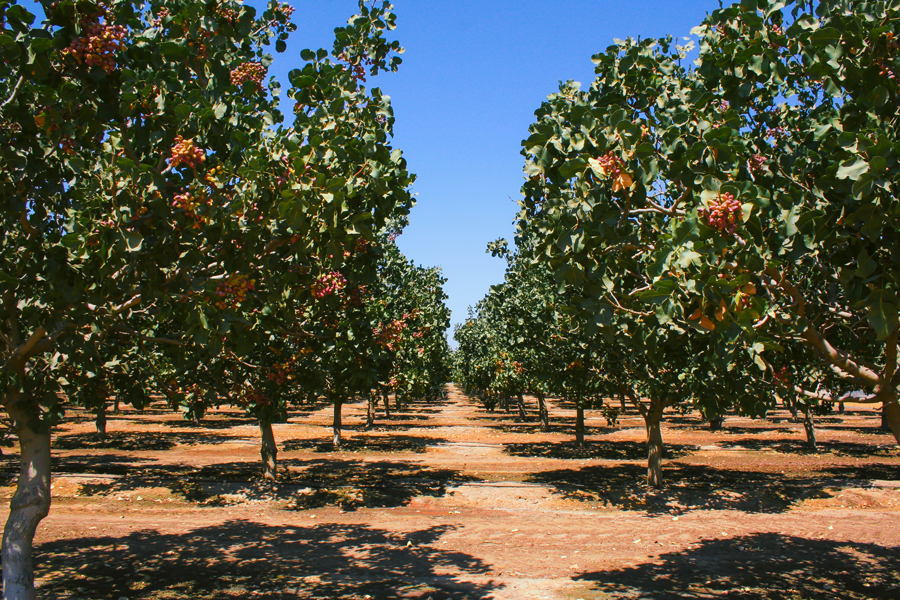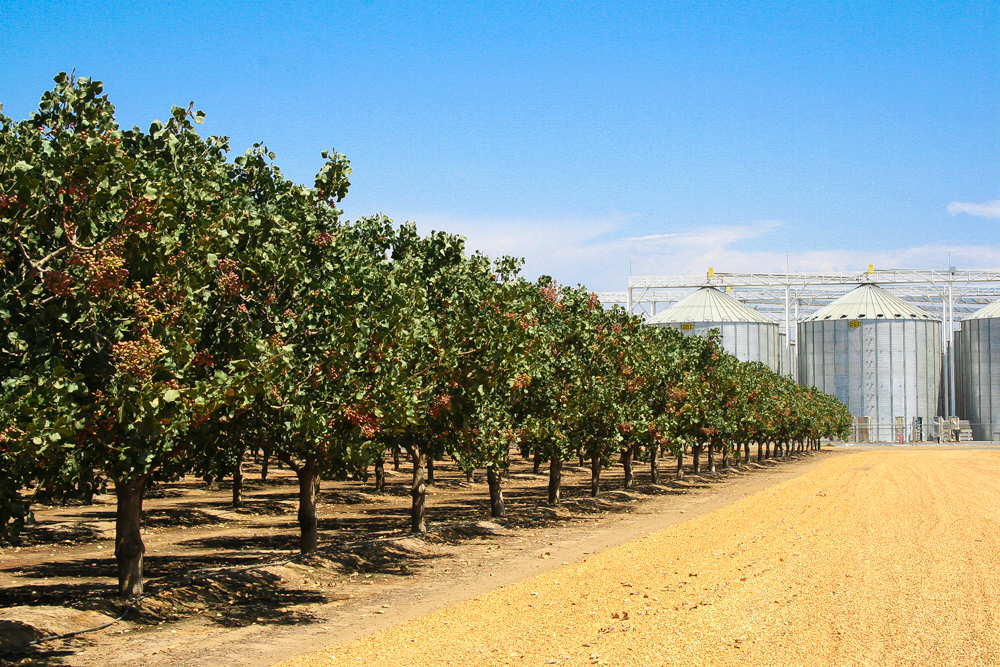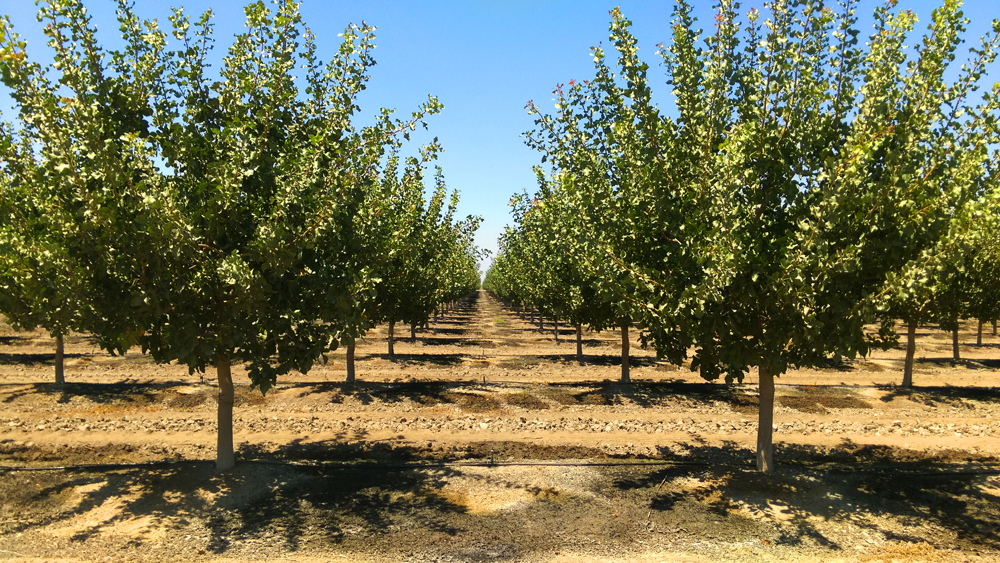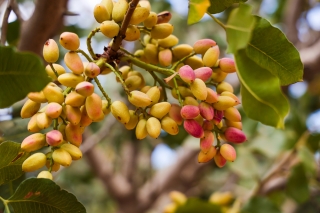 Pistachios are grown on trees and it can take up to seven years after planting for a tree to register its first crop. One tree can produce anywhere from 2 to 50 pounds of pistachios. Pistachio trees are typically harvested using a mechanical harvester that shakes the trees and collects all the pistachios before touching the ground. The pistachios are then loaded into a trailer and transported to a processing facility. In 2023, the U.S. pistachio harvest equated to nearly 1.5 billion pounds.
Pistachios are grown on trees and it can take up to seven years after planting for a tree to register its first crop. One tree can produce anywhere from 2 to 50 pounds of pistachios. Pistachio trees are typically harvested using a mechanical harvester that shakes the trees and collects all the pistachios before touching the ground. The pistachios are then loaded into a trailer and transported to a processing facility. In 2023, the U.S. pistachio harvest equated to nearly 1.5 billion pounds.
Pistachios are a complete protein, containing all nine essential amino acids necessary for supporting growth and maintaining health for those five years of age and older.
Setton Pistachio of Terra Bella, Inc. is the second-largest pistachio grower and processor in the country. The company’s ranches are located throughout California’s Central Valley and its central processing facility is in Terra Bella, Calif.
What care is taken to maintain the pistachio trees?
Each year, pistachio trees are cared for through the following activities:
- Irrigation is done regularly, especially during spring/summer, to ensure trees receive essential water.
- Pruning is annually completed during the winter dormant season to maintain the shape and size of the tree, promote airflow and remove dead or diseased branches.
- Pistachio trees benefit from regular fertilization to ensure proper nutrient uptake and overall health.
- Weeds can compete with pistachio trees for nutrients and water. Weed control is important to reduce competition and promote tree growth.
- Harvest timing is crucial to ensure optimal nut quality.
Technological advancements in the agriculture industry have also allowed us to reduce the use of resources and improve the overall performance and efficiency of our pistachio orchards. For example, remote sensing technology allows us to monitor overall crop health, identify areas of stress, and detect the presence of pests and diseases.
Additionally, the use of precision agriculture technology allows us to use real-time data to optimize our resource inputs by precisely applying water, fertilizers, and pesticides based on the specific needs of individual areas within our fields. These technological tools, among others, allow us to react quickly and implement changes where necessary to improve and maintain tree health to optimize yields.
After harvest, nutrient-rich compost is applied to our orchards, promoting healthy soils and reducing the need for synthetic fertilizers and soil amendments. We also plant cover crops annually to improve soil health and fertility by increasing organic matter, nitrogen, and water content. Cover crops also benefit by enhancing soil structure, aeration, and infiltration by breaking up soil compaction and creating pores. 
What environmental factors are important when farming pistachios?
Water is and will continue to be the most critical component of any farming operation in California. Periodic drought conditions have led to limited water resources and reduced water allocations for all farmers. We utilize water-saving technologies, implement efficient irrigation methods, and closely monitor our water usage. Additionally, we work closely with water management agencies and other institutions to identify sustainable water-use solutions in our pistachio orchards.
Please describe your farms’ sustainability efforts.
We are proud to call the Central Valley of California home. As we continue to grow, our philosophy of thoughtful and sustainable expansion drives all our efforts. We know firsthand how important it is to preserve our most precious natural resource, water. We reuse 130 million gallons of water annually, which recycles 100% of our discarded water. We also capture essential rainwater through collection ponds, which is then 100% re-applied through the irrigation system.
One hundred and fifty million pounds of hull biomass are re-purposed annually on a 40-acre composting facility that recycles 100% of our biomass ag-waste. This nutrient-rich compost is then reused in our orchards, promoting healthy soils and reducing the need for synthetic fertilizers and soil amendments.
One hundred percent of our post-harvest activities are solar-powered by our 1.7-megawatt solar power system.
 One hundred percent of our pistachio shells, totaling upwards of 40 million pounds, are reused to create roadbeds, minimizing dust and helping to clean our air.
One hundred percent of our pistachio shells, totaling upwards of 40 million pounds, are reused to create roadbeds, minimizing dust and helping to clean our air.
We are also advocates of regenerative agriculture, which is a holistic approach to farming that prioritizes soil health and biodiversity to promote sustainable and resilient ecosystems. It involves implementing practices that minimize negative impacts on the environment and actively improve it. In addition, healthy soils are the foundation for healthy orchards, and Setton’s commitment to regenerative agriculture has been key to improving pistachio quality for all pistachio growers. By embracing regenerative agriculture, the Setton family is ensuring that pistachio orchards thrive for generations to come.
What is the best thing about pistachios?
We love the power of pistachios and the numerous healthy benefits they contain. Research suggests that pistachios help maintain good health, support an active lifestyle, and reduce the risk of nutrition-related diseases.
- Pistachios have a high antioxidant capacity that rivals popular antioxidant-containing foods, including pomegranates and blueberries.
- Not only are pistachios a source of many essential vitamins and minerals, monounsaturated and polyunsaturated fatty acids, protein, and fiber, but pistachios also provide an array of phytochemicals, a wide variety of compounds made by plants that may help to promote health and well-being.
What is your favorite pistachio dish?
Pistachios are delicious and are loaded with protein, antioxidants, and many other nutrients! Whether you want to add a bright pop of green, a bit of crunch, or protein to your dishes, we’ve put together some of the best pistachio recipes to try. Find them on Instagram @Setton_Farms and our website SettonFarms.com.
Photos courtesy of Setton Pistachio Farms of Terra Bella, Inc.
